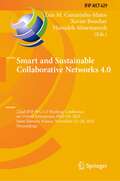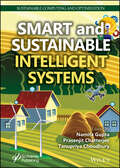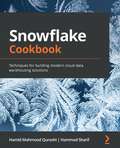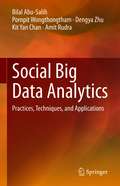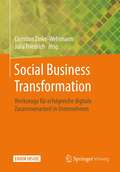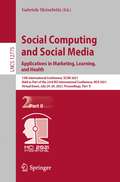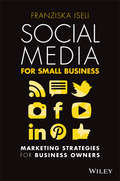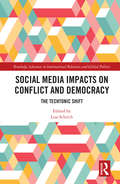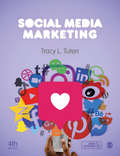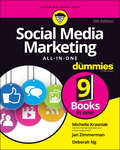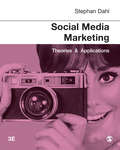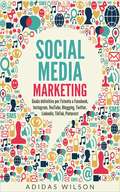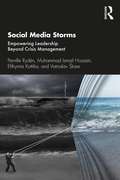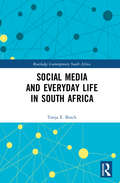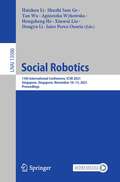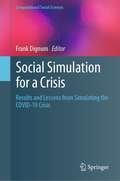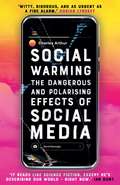- Table View
- List View
Smart Wireless Sensing: From IoT to AIoT
by Zheng Yang Yi Zhang Chenshu Wu Kun QianPerception of human beings has evolved from natural biosensor to powerful sensors and sensor networks. In sensor networks, trillions of devices are interconnected and sense a broad spectrum of contexts for human beings, laying the foundation of Internet of Things (IoT). However, sensor technologies have several limitations relating to deployment cost and usability, which render them unacceptable for practical use. Consequently, the pursuit of convenience in human perception necessitates a wireless, sensorless and contactless sensing paradigm.Recent decades have witnessed rapid developments in wireless sensing technologies, in which sensors detect wireless signals (such as acoustic, light, and radio frequency) originally designed for data transmission or lighting. By analyzing the signal measurements on the receiver end, channel characteristics can be obtained to convey the sensing results. Currently, significant effort is being devoted to employing the ambient Wi-Fi, RFID, Bluetooth, ZigBee, and television signals for smart wireless sensing, eliminating the need for dedicated sensors and promoting the prospect of the Artificial Intelligence of Things (AIoT). This book provides a comprehensive and in-depth discussion of wireless sensing technologies. Specifically, with a particular focus on Wi-Fi-based sensing for understanding human behavior, it adopts a top-down approach to introduce three key topics: human detection, localization, and activity recognition. Presenting the latest advances in smart wireless sensing based on an extensive review of state-of-the-art research, it promotes the further development of this area and also contributes to interdisciplinary research.
Smart and Sustainable Agriculture: First International Conference, SSA 2021, Virtual Event, June 21-22, 2021, Proceedings (Communications in Computer and Information Science #1470)
by Selma Boumerdassi Éric Renault Mounir GhoghoThis book constitutes the refereed proceedings of the First International Conference on Smart and Sustainable Agriculture, SSA 2021, held as a virtual event in June 2021. The 12 papers presented were thoroughly reviewed and selected from the 25 qualified submissions. The papers provide discussion on new trends in communication and networking, Internet of Things, data processing for smart agriculture, renewable-energy based devices, low-cost solutions for wide-area exploitations and developing countries, smart agriculture and urban farming, smart irrigation, application to small-size andlarge-size exploitations, application of ancestral farming to smart agriculture, waste management for agriculture 2.0, and census of regional ancestral farming.
Smart and Sustainable Collaborative Networks 4.0: 22nd IFIP WG 5.5 Working Conference on Virtual Enterprises, PRO-VE 2021, Saint-Étienne, France, November 22–24, 2021, Proceedings (IFIP Advances in Information and Communication Technology #629)
by Luis M. Camarinha-Matos Hamideh Afsarmanesh Xavier BoucherThis book constitutes the refereed proceedings of the 22nd IFIP WG 5.5 Working Conference on Virtual Enterprises, PRO-VE 2021, held in Saint-Étienne, and virtually in November 2021.The 70 papers (15 full and 55 short) presented with 5 industrial workshop papers were carefully reviewed and selected from 189 submissions. They provide a comprehensive overview of major challenges and recent advances in various domains related to the digital transformation and collaborative networks and their applications with a strong focus on the following areas related to the main theme of the conference: sustainable collaborative networks; sustainability via digitalization; analysis and assessment of business ecosystems; human factors in collaboration 4.0; maintenance and life-cycle management; policies and new digital services; safety and collaboration management; simulation and optimization; complex collaborative systems and ontologies; value co-creation in digitally enabled ecosystems; digitalization strategy in collaborative enterprises’ networks; pathways and tools for DIHs; socio-technical perspectives on smart product-service systems; knowledge transfer and accelerated innovation in FoF; interoperability of IoT and CPS for industrial CNs; sentient immersive response network; digital tools and applications for collaborative healthcare; collaborative networks and open innovation in education 4.0; collaborative learning networks with industry and academia; and industrial workshop.
Smart and Sustainable Intelligent Systems (Sustainable Computing and Optimization)
by Tanupriya Choudhury Namita Gupta Prasenjit ChatterjeeThe world is experiencing an unprecedented period of change and growth through all the electronic and technilogical developments and everyone on the planet has been impacted. What was once ‘science fiction’, today it is a reality. This book explores the world of many of once unthinkable advancements by explaining current technologies in great detail. Each chapter focuses on a different aspect - Machine Vision, Pattern Analysis and Image Processing - Advanced Trends in Computational Intelligence and Data Analytics - Futuristic Communication Technologies - Disruptive Technologies for Future Sustainability. The chapters include the list of topics that spans all the areas of smart intelligent systems and computing such as: Data Mining with Soft Computing, Evolutionary Computing, Quantum Computing, Expert Systems, Next Generation Communication, Blockchain and Trust Management, Intelligent Biometrics, Multi-Valued Logical Systems, Cloud Computing and security etc. An extensive list of bibliographic references at the end of each chapter guides the reader to probe further into application area of interest to him/her.
Smarte Services mit künstlicher Intelligenz: Best Practices der Transformation zum digitalisierten, datengetriebenen Unternehmen
by Egmont FothIn diesem Buch erfährt der Leser, wie smarte Services mit künstlicher Intelligenz realisierbar sind und wie eine digitale Transformation gelingt, mit der sich die Kundenorientierung, Wettbewerbsfähigkeit, Widerstandsfähigkeit, Agilität und Nachhaltigkeit von Unternehmen verbessern lässt. Was sind smarte Services und wie sehen sie in der Praxis aus? Was beinhalten die dafür erforderlichen Komponenten Internet of Things, Data Lake und Advanced Analytics? Wofür lässt sich die künstliche Intelligenz einsetzen und wie erfolgt das in der Praxis? Wie entsteht Digital Trust? Wie lässt sich der digitale Reifegrad von Unternehmen ermitteln? Welches Vorgehen hat sich für die digitale Transformation in der Praxis bewährt? Wofür wird ein digitales Ecosystem benötigt und wie kann es aussehen? Was wird unter „New Work“ verstanden? Wie arbeiten datengetriebene Unternehmen und welche Vorteile hat das? Was ist ein Digital Use Case? Wie läuft ein Use-Case-Entwicklungs-Workshop ab? Wie lässt sich ein Digital Use Case strukturiert beschreiben? Welche interessanten, innovativen Beispiele für Digital Use Cases gibt es? Wie erfolgt ein Proof of Concept? Wie lassen sich die Kernprozesse Order to Cash (O2C), Procure to Pay (P2P), Design to Operate (D2O), Recruit to Retire (R2R) und Awareness to Advocacy (A2A) digitalisieren? Welche neuen digitalen Technologien und in ihrem Zusammenhang angewandte Verfahren existieren?
Snowflake Cookbook: Techniques for building modern cloud data warehousing solutions
by Hamid Mahmood Qureshi Hammad SharifDevelop modern solutions with Snowflake's unique architecture and integration capabilities; process bulk and real-time data into a data lake; and leverage time travel, cloning, and data-sharing features to optimize data operationsKey FeaturesBuild and scale modern data solutions using the all-in-one Snowflake platformPerform advanced cloud analytics for implementing big data and data science solutionsMake quicker and better-informed business decisions by uncovering key insights from your dataBook DescriptionSnowflake is a unique cloud-based data warehousing platform built from scratch to perform data management on the cloud. This book introduces you to Snowflake's unique architecture, which places it at the forefront of cloud data warehouses. You'll explore the compute model available with Snowflake, and find out how Snowflake allows extensive scaling through the virtual warehouses. You will then learn how to configure a virtual warehouse for optimizing cost and performance. Moving on, you'll get to grips with the data ecosystem and discover how Snowflake integrates with other technologies for staging and loading data. As you progress through the chapters, you will leverage Snowflake's capabilities to process a series of SQL statements using tasks to build data pipelines and find out how you can create modern data solutions and pipelines designed to provide high performance and scalability. You will also get to grips with creating role hierarchies, adding custom roles, and setting default roles for users before covering advanced topics such as data sharing, cloning, and performance optimization. By the end of this Snowflake book, you will be well-versed in Snowflake's architecture for building modern analytical solutions and understand best practices for solving commonly faced problems using practical recipes.What you will learnGet to grips with data warehousing techniques aligned with Snowflake's cloud architectureBroaden your skills as a data warehouse designer to cover the Snowflake ecosystemTransfer skills from on-premise data warehousing to the Snowflake cloud analytics platformOptimize performance and costs associated with a Snowflake solutionStage data on object stores and load it into SnowflakeSecure data and share it efficiently for accessManage transactions and extend Snowflake using stored proceduresExtend cloud data applications using Spark ConnectorWho this book is forThis book is for data warehouse developers, data analysts, database administrators, and anyone involved in designing, implementing, and optimizing a Snowflake data warehouse. Knowledge of data warehousing and database and cloud concepts will be useful. Basic familiarity with Snowflake is beneficial, but not necessary.
Sobreviviendo a la IA: La promesa y el peligro de la Inteligencia Artificial
by Calum ChaceEste es el siglo de las dos singularidades: la singularidad económica (desempleo tecnológico) y la singularidad tecnológica (la explosión de la inteligencia). Ambas presentan enormes oportunidades y enormes desafíos. Si las manejamos con éxito, nuestro futuro como especie será más que maravilloso. Si fallamos, podría ser miserable, y quizás breve. El impulsor es la inteligencia artificial (IA), la tecnología más poderosa de la humanidad. El software que resuelve problemas y convierte los datos en valiosa información ya ha revolucionado nuestras vidas, y la revolución se está acelerando. En 2015, la inteligencia artificial ocupaba las primeras planas, y con justa razón. Se está acercando a un punto de inflexión en el que las máquinas pueden realizar mejor que nosotros muchas tareas que antes se consideraban exclusivamente humanas. Los sistemas de aprendizaje profundo están a punto de reconocer imágenes y comprender el lenguaje natural mejor que los humanos. El argumento de este libro es que debemos monitorear los cambios que están ocurriendo y adoptar políticas que fomenten los mejores resultados posibles. La gama de posibles resultados es amplia, desde los terribles hasta los maravillosos, y no están predeterminados. Serán seleccionados en parte por suerte, en parte por su propia lógica interna, pero en parte también por las políticas adoptadas en todos los niveles de la sociedad. La automatización y la superinteligencia son los dos desarrollos que ya podemos prever causarán grandes impactos. La automatización podría conducir a una singularidad económica y la evolución a un tipo de economía completamente diferente. Si nos equivocamos, una élite podría poseer los medios de producción y reprimir al resto de nosotros en un autoritario régimen tecnológico distópico. Si lo hacemos bien, podríamos disfrutar de una economía de abundancia radical, donde nadie tiene que trabajar para ganarse la vida, y todos somos libres para divert
Social Big Data Analytics: Practices, Techniques, and Applications
by Pornpit Wongthongtham Bilal Abu-Salih Dengya Zhu Kit Yan Chan Amit RudraThis book focuses on data and how modern business firms use social data, specifically Online Social Networks (OSNs) incorporated as part of the infrastructure for a number of emerging applications such as personalized recommendation systems, opinion analysis, expertise retrieval, and computational advertising. This book identifies how in such applications, social data offers a plethora of benefits to enhance the decision making process.This book highlights that business intelligence applications are more focused on structured data; however, in order to understand and analyse the social big data, there is a need to aggregate data from various sources and to present it in a plausible format. Big Social Data (BSD) exhibit all the typical properties of big data: wide physical distribution, diversity of formats, non-standard data models, independently-managed and heterogeneous semantics but even further valuable with marketing opportunities.The book provides a review of the current state-of-the-art approaches for big social data analytics as well as to present dissimilar methods to infer value from social data. The book further examines several areas of research that benefits from the propagation of the social data. In particular, the book presents various technical approaches that produce data analytics capable of handling big data features and effective in filtering out unsolicited data and inferring a value. These approaches comprise advanced technical solutions able to capture huge amounts of generated data, scrutinise the collected data to eliminate unwanted data, measure the quality of the inferred data, and transform the amended data for further data analysis. Furthermore, the book presents solutions to derive knowledge and sentiments from BSD and to provide social data classification and prediction. The approaches in this book also incorporate several technologies such as semantic discovery, sentiment analysis, affective computing and machine learning.This book has additional special feature enriched with numerous illustrations such as tables, graphs and charts incorporating advanced visualisation tools in accessible an attractive display.
Social Business Transformation: Werkzeuge für erfolgreiche digitale Zusammenarbeit in Unternehmen
by Julia Friedrich Christian Zinke-WehlmannDie Zukunft der Arbeit verlagert sich zunehmend in den digitalen Raum. Deutsche Unternehmen positionieren sich in der Gestaltung dieses Raumes bislang häufig in der Rolle der Nachzügler, weil sie die Bedeutung des Einsatzes sozialer Technologien (z.B. Enterprise Social Networks) für das Unternehmen unterschätzen. Das resultierende Risiko im globalen Wettbewerb unterzugehen, ist gerade für den Mittelstand erheblich.Um zukunftsfähige Wege einzuschlagen, braucht es neue Gestaltungsansätze. Einer davon ist Social Business. Social Business wird im vorliegenden Werk als ganzheitliches Konzept beschrieben, welches durch den systematischen Einsatz digitaler und kollaborativer Werkzeuge neue Möglichkeiten der Innovation und Wertschöpfung schafft. Soziale Technologien ermöglichen eine proaktive Gestaltung unternehmensinterner und -übergreifender Prozesse und bieten insbesondere im Wissensmanagement, in der Kommunikation sowie der Zusammenarbeit produktionssteigernde Potenziale.Im Rahmen dieses Werkes werden praktische Anwendungen, Konzepte zur Umsetzung von Social Business und Leitlinien für den Transformationsprozess wissenschaftlich fundiert und praxisnah präsentiert.
Social Computing and Social Media: 13th International Conference, SCSM 2021, Held as Part of the 23rd HCI International Conference, HCII 2021, Virtual Event, July 24–29, 2021, Proceedings, Part I (Lecture Notes in Computer Science #12774)
by Gabriele MeiselwitzThis two-volume set LNCS 12774 and 12775 constitutes the refereed proceedings of the 12th International Conference on Social Computing and Social Media, SCSM 2021, held as part of the 23rd International Conference, HCI International 2021, which took place in July 2021. Due to COVID-19 pandemic the conference was held virtually. The total of 1276 papers and 241 poster papers included in the 39 HCII 2021 proceedings volumes was carefully reviewed and selected from 5222 submissions. The regular papers of SCSM 2021, Part I, are organized in topical sections named: Computer Mediated Communication; Social Network Analysis; Experience Design in Social Computing.
Social Computing and Social Media: 13th International Conference, SCSM 2021, Held as Part of the 23rd HCI International Conference, HCII 2021, Virtual Event, July 24–29, 2021, Proceedings, Part II (Lecture Notes in Computer Science #12775)
by Gabriele MeiselwitzThis two-volume set LNCS 12774 and 12775 constitutes the refereed proceedings of the 12th International Conference on Social Computing and Social Media, SCSM 2021, held as part of the 23rd International Conference, HCI International 2021, which took place in July 2021. Due to COVID-19 pandemic the conference was held virtually. The total of 1276 papers and 241 poster papers included in the 39 HCII 2021 proceedings volumes was carefully reviewed and selected from 5222 submissionsThe regular papers of SCSM 2021, Part II, are organized in topical sections named: SCSM in Marketing and Customer Behavior; Social Computing in Learning and Education; SCSM in Health and Wellbeing.
Social Media For Small Business: Marketing Strategies for Business Owners
by Franziska IseliDiscover how social media can transform your business and help you attract more customers Social Media For Small Business delivers a step-by-step guide to unlocking the potential of social media to grow your business. Award-winning author and entrepreneur Franziska Iseli walks you through how to use Facebook, LinkedIn, Instagram, YouTube, Twitter, and Pinterest to market your small-to medium-sized business. The book provides you with: Effective marketing strategies to get more out of your social media efforts. Systems to bring structure into your entire marketing approach. Tools to make your brand irresistible across your customer touchpoints. Case studies to highlight the application of the book’s principles to the real-world Practical strategies you can put in place immediately to see a rapid return on investment Perfect for busy business owners, business managers and marketing teams wanting to find new and effective marketing tools to attract more customers, Social Media For Small Business also belongs on the bookshelves of anyone who has difficulty with or wants to learn more about how social media can have a positive impact on their business and brand.
Social Media Impacts on Conflict and Democracy: The Techtonic Shift (Routledge Advances in International Relations and Global Politics)
by Lisa SchirchSocial media technology is having a dramatic impact on social and political dynamics around the world. The contributors to this book document and illustrate this "techtonic" shift on violent conflict and democratic processes. They present vivid examples and case studies from countries in Africa, South and Southeast Asia, Latin America as well as Northern Ireland. Each author maps an array of peacebuilding solutions to social media threats, including coordinated action by civil society, governments and tech companies to protect human minds, relationships and institutions. Solutions presented include inoculating society with a new digital literacy agenda, designing technology for positive social impacts, and regulating technology to prohibit the worst behaviours. A must-read both for political scientists and policymakers trying to understand the impact of social media, and media studies scholars looking for a global perspective.
Social Media Marketing
by Tracy L. Tuten**Winner of the TAA 2017 Textbook Excellence Award** "Social Media Marketing deserves special kudos for its courage in tackling the new frontier of social media marketing. This textbook challenges its readers to grapple with the daunting task of understanding rapidly evolving social media and its users." TAA Judges Panel The market leading and award winning text on social media marketing has been fully updated for this fourth edition. With a balance of essential theory and practical application, the text has been been thoroughly revised to reflect the latest developments in social media marketing research and practice. 11 new case studies have been added to the ′Case Zone′, including TikTok, LEGO, Nespresso and Puma. A student-engaging case study now runs throughout the entire textbook looking at the US based company Kombucha 221 BC to help develop understanding of each chapter. The book is complemented by a companion website that offers valuable additional resources for both instructors and students, including author videos discussing key social media marketing ideas and concepts, author-selected YouTube video playlists, additional case studies, further weblinks, PowerPoint slides and Testbank. A must-have text for those studying social media marketing.
Social Media Marketing
by Tracy L. Tuten**Winner of the TAA 2017 Textbook Excellence Award** "Social Media Marketing deserves special kudos for its courage in tackling the new frontier of social media marketing. This textbook challenges its readers to grapple with the daunting task of understanding rapidly evolving social media and its users." TAA Judges Panel The market leading and award winning text on social media marketing has been fully updated for this fourth edition. With a balance of essential theory and practical application, the text has been been thoroughly revised to reflect the latest developments in social media marketing research and practice. 11 new case studies have been added to the ′Case Zone′, including TikTok, LEGO, Nespresso and Puma. A student-engaging case study now runs throughout the entire textbook looking at the US based company Kombucha 221 BC to help develop understanding of each chapter. The book is complemented by a companion website that offers valuable additional resources for both instructors and students, including author videos discussing key social media marketing ideas and concepts, author-selected YouTube video playlists, additional case studies, further weblinks, PowerPoint slides and Testbank. A must-have text for those studying social media marketing.
Social Media Marketing All-in-One For Dummies
by Jan Zimmerman Deborah Ng Michelle KrasniakGet social with the bestselling social media marketing book No person can ignore social media these days—and no business can afford to ignore it either. Our lives are mediated through the flicker of Facebook, Twitter, YouTube, and Instagram—and brands are increasingly interwoven with our online identities. Even for the 90% of marketers who interact with social media regularly, its pace and scale can be confusing to the point of distraction. Social Media Marketing All-in-One For Dummies helps you take a step back, make sense of the noise, and get your brand voice heard over the babble—in the way you want it to be. These nine mini-books in one give you essential, straightforward, and friendly guidance on how to use the major social platforms to promote your business, engage your customers, and use feedback to make your product or service the best that it can be. From evaluating the right social mix and planning your strategy to the really fun stuff—like creating videos on Snapchat and TikTok, diving deep on a podcast, or looking pretty on Pinterest—you’ll find everything you need to get your social ducks in a row and say the right things. And once the campaign is over, you can follow the guidance here to evaluate success and iterate on your approach, before getting right back out there for an even bigger second bite. Keep up with the latest changes on Twitter, Facebook, LinkedIn, TikTok, and more Blend your social side with your traditional marketing presence Become more engaging and metric your success Get to know your fans with user data Wherever you’re coming from—social media strategist, site manager, marketer, or something else—social media is where your customers are. This book shows you how to be there, too.
Social Media Marketing: Theories and Applications
by Stephan DahlHelping you make the connections between the theory and practice of social media marketing, this third edition of the popular text has been updated to include technological advances in practice such as AI and virtual marketing, alongside a brand-new chapter on the rise of influencer culture and marketing. Examples and case studies throughout help you to contextualise the text through popular brands and platforms such as Instagram, Dunkin Donuts, Amazon and also political marketing for social movements such as Extinction Rebellion. This text is essential reading for all marketing students, researchers and practitioners today.
Social Media Marketing: Theories and Applications
by Stephan DahlHelping you make the connections between the theory and practice of social media marketing, this third edition of the popular text has been updated to include technological advances in practice such as AI and virtual marketing, alongside a brand-new chapter on the rise of influencer culture and marketing. Examples and case studies throughout help you to contextualise the text through popular brands and platforms such as Instagram, Dunkin Donuts, Amazon and also political marketing for social movements such as Extinction Rebellion. This text is essential reading for all marketing students, researchers and practitioners today.
Social Media Marketing: guida definitiva per l'utente su Facebook, Instagram, YouTube, Blogging, Twitter, LinkedIn,
by Adidas WilsonCosa si intende quando si parla di coinvolgimento sui Social Media? La risposta è semplice: è il numero di condivisioni, Mi piace e commenti. Sicuramente, avere un grande seguito è fantastico, ma bisogna ricordare che è sempre meglio puntare alla qualità che alla quantità e un pubblico impegnato è meglio di uno grande. Esistono alcune metriche utilizzate per misurare il coinvolgimento sui Social Media tra i quali: l’uso di hashtag brandizzati, le menzioni, i click-through, la crescita dei follower, i “Mi piace”, i Commenti, i Retweet e le condivisioni. I tuoi follower possono iniziare a interagire con i tuoi contenuti in maniera naturale. Ma spesso, potresti dover incoraggiarli un po'. Ci sono alcuni trucchi che possono aiutarti a raggiungere tale obiettivo. Valuta il tuo coinvolgimento: guarda quanti follower hai, il numero medio di condivisioni e commenti che ricevi su ogni post e qualsiasi altro numero rilevante. Assicurati di continuare a monitorare questi numeri. Scegli la tua strategia: ogni azienda ha obiettivi diversi e le strategie sono, quindi, diverse. La tua strategia dipenderà dai tuoi obiettivi. Potrebbe essere educare il pubblico, raccogliere feedback, cambiare la percezione del pubblico, ecc. Comprendi il tuo pubblico: non è facile coinvolgere persone che non conosci.
Social Media Storms: Empowering Leadership Beyond Crisis Management
by Pernille Rydén Muhammad Ismail Hossain Efthymia Kottika Vatroslav ŠkareThis fascinating new book explores the benefits and dynamics of social media storms and identifies the possible opportunities that they present for further engagement with customers. It provides actionable managerial advice on planning for, measuring, and innovatively navigating social media storms. Based on a sound theoretical background and illustrated by vivid real-life examples and case studies throughout every chapter, this book combines thorough explanations of the elements of business decision-making, market interaction, consumer psychology, branding, and business communication. In comparison to the existing literature, the book departs from the classical, but insufficient crisis communication management approaches to suggest novel frameworks and tools for empowering businesses, consumers, and broader societies in the digital age. Social Media Storms: Empowering Leadership Beyond Crisis Management provides advanced undergraduate and postgraduate digital marketing, marketing communications, strategy, and crisis management students with a comprehensive understanding of the social media storm phenomenon and helps marketing and communications professionals to leverage the opportunities that social media storms are bringing.
Social Media and Everyday Life in South Africa (Routledge Contemporary South Africa)
by Tanja E BoschThis book explores how social media is used in South Africa, through a range of case studies exploring various social networking sites and applications. This volume explores how, over the past decade, social media platforms have deeply penetrated the fabric of everyday life. The author considers South Africans’ use of wearable tech and use of online health and sports tracking systems via mobile phones within the broader context of the digital data economy. The author also focuses on the dating app Tinder, to show how people negotiate and redefine intimacy through the practice of online dating via strategic performances in pursuit of love, sex and intimacy. The book concludes with the use of Facebook and Twitter for social activism (e.g. Fees Must Fall), as well as networked community building as in the case of the #ImStaying movement. This book will be of interest to social media academics and students, as well as anyone interested in social media, politics and cultural life in South Africa.
Social Media für Führungskräfte: Behalten Sie das Steuer in der Hand
by Stefanie BabkaDieses Buch bietet Ihnen einen knappen und präzisen Überblick zu den wichtigsten unternehmerischen Herausforderungen sowie Chancen und Risiken in Bezug auf Social Media. Unabhängig davon, welche Art und Größe von Unternehmen oder Abteilung Sie leiten, ob Sie Industriegüter, Konsumgüter oder Dienstleistungen anbieten – Social Media ist ein Faktor, den Sie beobachten und steuern sollten. Stefanie Babka hilft Ihnen dabei, sich und Ihren Mitarbeitern die richtigen Fragen zu stellen, Antworten zu finden und sich so den internen Herausforderungen zu stellen. Denn Social Media ist eine Führungsaufgabe.Dabei werden zum Beispiel folgende Fragestellungen beleuchtet: Sind Sie sich der Risiken von unkoordiniertem und unsachgemäßem Umgang mit Social Media durch Ihre Mitarbeiter im privaten oder beruflichen Umfeld bewusst? Haben Sie datenschutzrechtlich alles beachtet, oder stehen Sie als Führungskraft bereits mit einem Fuß im Gefängnis? Geben Sie zu viel Geld für Social-Media-Kampagnen aus? Haben Sie die richtige Social-Media-Strategie? Orientiert sich diese an den Unternehmenszielen? Haben Sie das Ruder in der Hand oder herrscht in Ihrem Unternehmen Social-Media-Anarchie? Welche Chancen und Risiken bringen interne Social-Media-Anwendungen für die Zusammenarbeit in Teams oder Organisationseinheiten? Wie kann Social Media als strategisches Führungsinstrument genutzt werden? Social Media geht jedes Unternehmen an. Ob Sie wollen oder nicht.Für die 2. Auflage wurden alle Inhalte überarbeitet und das Kapitel „Als Führungskraft im Social Web“ wurde unter anderem um das Thema virtuelles Management und Führung von virtuellen Teams erweitert.
Social Robotics: 13th International Conference, ICSR 2021, Singapore, Singapore, November 10–13, 2021, Proceedings (Lecture Notes in Computer Science #13086)
by Shuzhi Sam Ge Yan Wu Hongsheng He Haizhou Li Agnieszka Wykowska Xiaorui Liu Dongyu Li Jairo Perez-OsorioThis book constitutes the refereed proceedings of the 13th International Conference on Social Robotics, ICSR 2021, held in Singapore, Singapore, in November 2021. The conference was held as a hybrid event.The 64 full papers and 15 short papers presented were carefully reviewed and selected from 114 submissions. The conference presents topics on humans and intelligent robots and on the integration of robots into the fabric of our society. The theme of the 2021 edition was “Robotics in our everyday lives”, emphasizing on the increasing importance of robotics in human daily living.
Social Simulation for a Crisis: Results and Lessons from Simulating the COVID-19 Crisis (Computational Social Sciences)
by Frank DignumSimulating for a crisis is far more than creating a simulation of a crisis situation. In order for a simulation to be useful during a crisis, it should be created within the space of a few days to allow decision makers to use it as quickly as possible. Furthermore, during a crisis the aim is not to optimize just one factor, but to balance various, interdependent aspects of life. In the COVID-19 crisis, decisions had to be made concerning e.g. whether to close schools and restaurants, and the (economic) consequences of a 3 or 4-week lock-down had to be considered. As such, rather than one simulation focusing on a very limited aspect, a framework allowing the simulation of several different scenarios focusing on different aspects of the crisis was required. Moreover, the results of the simulations needed to be easily understandable and explainable: if a simulation indicates that closing schools has no effect, this can only be used if the decision makers can explain why this is the case. This book describes how a simulation framework was created for the COVID-19 crisis, and demonstrates how it was used to simulate a wide range of scenarios that were relevant for decision makers at the time. It also discusses the usefulness of the approach, and explains the decisions that had to be made along the way as well as the trade-offs. Lastly, the book examines the lessons learned and the directions for the further development of social simulation frameworks to make them better suited to crisis situations, and to foster a more resilient society.
Social Warming: The Dangerous and Polarising Effects of Social Media
by Charles ArthurNobody meant for this to happen. Facebook didn&’t mean to facilitate a genocide. Twitter didn&’t want to be used to harass women. YouTube never planned to radicalise young men. But with billions of users, these platforms need only tweak their algorithms to generate more &‘engagement&’. In so doing, they bring unrest to previously settled communities and erode our relationships. Social warming has happened gradually – as a by-product of our preposterously convenient digital existence. But the gradual deterioration of our attitudes and behaviour on- and offline – this vicious cycle of anger and outrage – is real. And it can be corrected. Here&’s how.


